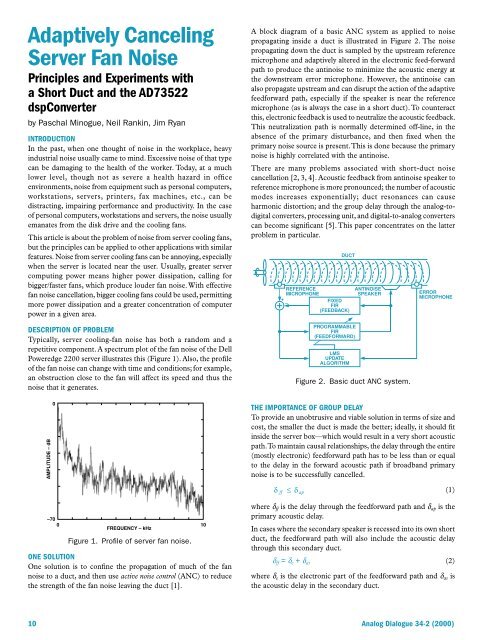Demystifying Auto-Zero Amplifiers—Part 1 - Analog Devices
Demystifying Auto-Zero Amplifiers—Part 1 - Analog Devices
Demystifying Auto-Zero Amplifiers—Part 1 - Analog Devices
Create successful ePaper yourself
Turn your PDF publications into a flip-book with our unique Google optimized e-Paper software.
Adaptively Canceling<br />
Server Fan Noise<br />
Principles and Experiments with<br />
a Short Duct and the AD73522<br />
dspConverter<br />
by Paschal Minogue, Neil Rankin, Jim Ryan<br />
INTRODUCTION<br />
In the past, when one thought of noise in the workplace, heavy<br />
industrial noise usually came to mind. Excessive noise of that type<br />
can be damaging to the health of the worker. Today, at a much<br />
lower level, though not as severe a health hazard in office<br />
environments, noise from equipment such as personal computers,<br />
workstations, servers, printers, fax machines, etc., can be<br />
distracting, impairing performance and productivity. In the case<br />
of personal computers, workstations and servers, the noise usually<br />
emanates from the disk drive and the cooling fans.<br />
This article is about the problem of noise from server cooling fans,<br />
but the principles can be applied to other applications with similar<br />
features. Noise from server cooling fans can be annoying, especially<br />
when the server is located near the user. Usually, greater server<br />
computing power means higher power dissipation, calling for<br />
bigger/faster fans, which produce louder fan noise. With effective<br />
fan noise cancellation, bigger cooling fans could be used, permitting<br />
more power dissipation and a greater concentration of computer<br />
power in a given area.<br />
A block diagram of a basic ANC system as applied to noise<br />
propagating inside a duct is illustrated in Figure 2. The noise<br />
propagating down the duct is sampled by the upstream reference<br />
microphone and adaptively altered in the electronic feed-forward<br />
path to produce the antinoise to minimize the acoustic energy at<br />
the downstream error microphone. However, the antinoise can<br />
also propagate upstream and can disrupt the action of the adaptive<br />
feedforward path, especially if the speaker is near the reference<br />
microphone (as is always the case in a short duct). To counteract<br />
this, electronic feedback is used to neutralize the acoustic feedback.<br />
This neutralization path is normally determined off-line, in the<br />
absence of the primary disturbance, and then fixed when the<br />
primary noise source is present. This is done because the primary<br />
noise is highly correlated with the antinoise.<br />
There are many problems associated with short-duct noise<br />
cancellation [2, 3, 4]. Acoustic feedback from antinoise speaker to<br />
reference microphone is more pronounced; the number of acoustic<br />
modes increases exponentially; duct resonances can cause<br />
harmonic distortion; and the group delay through the analog-todigital<br />
converters, processing unit, and digital-to-analog converters<br />
can become significant [5]. This paper concentrates on the latter<br />
problem in particular.<br />
DUCT<br />
REFERENCE<br />
MICROPHONE<br />
FIXED<br />
FIR<br />
(FEEDBACK)<br />
ANTINOISE<br />
SPEAKER<br />
ERROR<br />
MICROPHONE<br />
+<br />
–<br />
Figure 2. Basic duct ANC system.<br />
DESCRIPTION OF PROBLEM<br />
Typically, server cooling-fan noise has both a random and a<br />
repetitive component. A spectrum plot of the fan noise of the Dell<br />
Poweredge 2200 server illustrates this (Figure 1). Also, the profile<br />
of the fan noise can change with time and conditions; for example,<br />
an obstruction close to the fan will affect its speed and thus the<br />
noise that it generates.<br />
PROGRAMMABLE<br />
FIR<br />
(FEEDFORWARD)<br />
LMS<br />
UPDATE<br />
ALGORITHM<br />
AMPLITUDE – dB<br />
0<br />
THE IMPORTANCE OF GROUP DELAY<br />
To provide an unobtrusive and viable solution in terms of size and<br />
cost, the smaller the duct is made the better; ideally, it should fit<br />
inside the server box—which would result in a very short acoustic<br />
path. To maintain causal relationships, the delay through the entire<br />
(mostly electronic) feedforward path has to be less than or equal<br />
to the delay in the forward acoustic path if broadband primary<br />
noise is to be successfully cancelled.<br />
δ<br />
ff<br />
≤ δ<br />
(1)<br />
ap<br />
–70<br />
0 10<br />
FREQUENCY – kHz<br />
Figure 1. Profile of server fan noise.<br />
ONE SOLUTION<br />
One solution is to confine the propagation of much of the fan<br />
noise to a duct, and then use active noise control (ANC) to reduce<br />
the strength of the fan noise leaving the duct [1].<br />
where δ ff is the delay through the feedforward path and δ ap is the<br />
primary acoustic delay.<br />
In cases where the secondary speaker is recessed into its own short<br />
duct, the feedforward path will also include the acoustic delay<br />
through this secondary duct.<br />
δ ff = δ e + δ as (2)<br />
where δ e is the electronic part of the feedforward path and δ as is<br />
the acoustic delay in the secondary duct.<br />
10 <strong>Analog</strong> Dialogue 34-2 (2000)
















